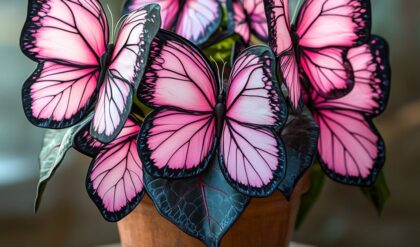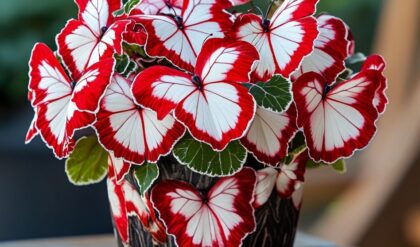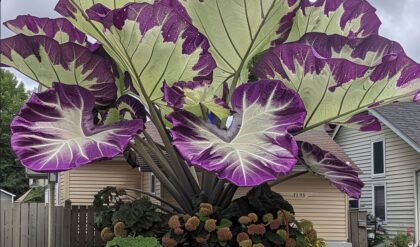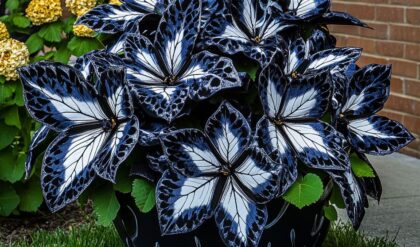The Blue Night Spark Begonia is a captivating and exotic plant that has enchanted indoor gardeners with its mesmerizing foliage. This guide will provide you with in-depth knowledge and practical tips to successfully grow and care for this stunning begonia variety, ensuring it thrives in your home environment.

Understanding the Blue Night Spark Begonia
The Blue Night Spark Begonia is a true gem in the world of ornamental plants. Its allure lies in its unique appearance and the challenges it presents to even the most experienced plant enthusiasts.
Origin and Characteristics
The Blue Night Spark Begonia is a hybrid cultivar, resulting from the careful breeding of Begonia rex and Begonia bowerae. This parentage has bestowed upon it some truly remarkable features:
The most striking aspect of this begonia is undoubtedly its foliage. Unlike the heart-shaped leaves common to many begonia species, the Blue Night Spark boasts elongated, spear-like leaves. These leaves are what give the plant its name and fame.
The leaves are covered in a layer of fine hairs, which create an iridescent effect when light hits them. This results in a stunning metallic blue sheen that seems to sparkle, hence the “Night Spark” in its name. The blue is often accompanied by silver speckles or streaks, adding to the plant’s otherworldly appearance.
While the foliage is the main attraction, the Blue Night Spark Begonia does produce flowers. However, these are usually small and pale in comparison to the dramatic leaves, and many growers choose to remove them to encourage more leaf growth.
Natural Habitat and Growth Habits
Understanding the natural habitat of the Blue Night Spark Begonia is crucial for providing it with optimal care:
In its native environment, this begonia thrives in the understory of tropical forests. This habitat preference translates to a need for bright, indirect light in cultivation. Direct sunlight can scorch the delicate leaves, while too little light will result in lackluster growth and faded colors.
As a tropical plant, the Blue Night Spark Begonia is accustomed to warm temperatures and high humidity. It’s not frost-hardy and is typically grown as an indoor plant in most climates. In its natural setting, it would receive nutrients from decomposing organic matter on the forest floor, which hints at its preference for rich, well-draining soil in cultivation.
The growth habit of the Blue Night Spark Begonia is generally compact and bushy. With proper care, it can reach a height of about 12-18 inches (30-45 cm) and spread to a similar width. This makes it an ideal specimen for terrariums, dish gardens, or as a standalone potted plant.
The Appeal of Blue Night Spark Begonia
What makes the Blue Night Spark Begonia so appealing to plant enthusiasts? There are several factors:
Firstly, its unusual coloration sets it apart from other houseplants. The metallic blue hue is rare in the plant world, making this begonia a true conversation piece. Its shimmering leaves can add a touch of magic to any indoor space, creating a focal point that draws the eye and sparks curiosity.

Secondly, while it requires specific care, the Blue Night Spark Begonia is not overly demanding once its basic needs are met. This makes it accessible to intermediate growers looking to challenge themselves beyond basic houseplants.
Lastly, the compact size of this begonia makes it suitable for a variety of living spaces. Whether you have a spacious home or a small apartment, you can find a spot for this stunning plant. Its versatility in terms of display options – from terrariums to hanging baskets – adds to its appeal.
Creating the Ideal Environment
To ensure your Blue Night Spark Begonia thrives, it’s crucial to recreate its natural habitat as closely as possible. This involves carefully managing light, temperature, and humidity levels.
Optimal Lighting Conditions
Light is perhaps the most critical factor in growing a healthy Blue Night Spark Begonia. Striking the right balance is key to maintaining its vibrant colors and promoting robust growth.
Bright, indirect light is the golden rule for this begonia. In nature, it grows beneath the canopy of larger trees, receiving dappled sunlight filtered through leaves. To replicate this in your home:
Place your Blue Night Spark Begonia near a north or east-facing window. These orientations typically provide gentle morning sun or consistent bright light without the harsh intensity of direct afternoon rays. If you only have south or west-facing windows, use sheer curtains or place the plant a few feet away from the window to diffuse the light.
Artificial lighting can also be beneficial, especially in darker homes or during winter months. LED grow lights can supplement natural light and help maintain the plant’s vivid coloration. Position the lights about 6-12 inches above the plant and provide 12-14 hours of light daily.
Pay attention to your begonia’s response to its light conditions. If the leaves start to fade or lose their metallic sheen, it might be receiving too much light. Conversely, if the plant becomes leggy or the leaves turn a darker green, it may need more light.
Temperature Management
As a tropical plant, the Blue Night Spark Begonia thrives in warm conditions. Understanding and maintaining the right temperature range is crucial for its health and growth.
The ideal temperature range for this begonia is between 65°F to 75°F (18°C to 24°C). This range mimics the consistent warmth of its native habitat. However, the plant can tolerate slightly higher temperatures, up to about 80°F (27°C), as long as it’s not exposed to direct sunlight and has adequate humidity.
It’s important to note that this begonia is sensitive to cold. Temperatures below 60°F (15°C) can cause stress, leading to leaf drop and stunted growth. Protect your plant from cold drafts by keeping it away from air conditioning vents, drafty windows, or frequently opened exterior doors.
During winter, be mindful of temperature fluctuations. Keep the plant away from cold windows at night, and consider using a thermometer to monitor the temperature in its immediate vicinity. If you live in a colder climate, you might need to move the plant to a warmer spot or use a heating mat designed for plants during the coldest months.
Humidity Requirements
High humidity is crucial for the Blue Night Spark Begonia to truly thrive. In its natural habitat, this plant would be surrounded by the moist air of a tropical forest. Replicating these conditions can be challenging in most homes, but there are several effective methods to increase humidity:
One of the simplest ways to boost humidity is by using a pebble tray. Place a layer of pebbles in a shallow tray, add water until it’s just below the top of the pebbles, and set your plant pot on top. As the water evaporates, it creates a humid microclimate around the plant.

Grouping plants together can also increase local humidity. As plants transpire, they release moisture into the air, benefiting neighboring plants. Place your Blue Night Spark Begonia near other humidity-loving plants for mutual benefit.
For a more high-tech solution, consider using a humidifier. This allows you to precisely control the humidity levels in the room. Aim for a humidity level between 50-70% for optimal growth.
Misting can provide a temporary humidity boost, but be cautious. Mist in the morning to allow water droplets to evaporate before nightfall, reducing the risk of fungal issues. However, don’t rely solely on misting, as its effects are short-lived.
Soil and Nutrition
The foundation of a healthy Blue Night Spark Begonia lies in its soil and nutrition. Providing the right growing medium and proper fertilization is crucial for robust growth and vibrant foliage.
Selecting the Right Soil Mix
The ideal soil for Blue Night Spark Begonia should be well-draining yet moisture-retentive. This balance is crucial to prevent root rot while ensuring the plant has access to the water it needs.
A good starting point is a peat-based potting mix. Peat moss provides excellent water retention and aeration. However, peat alone can become compacted over time, so it’s important to amend it:
Add perlite or vermiculite to improve drainage and prevent soil compaction. A ratio of 2 parts peat-based mix to 1 part perlite or vermiculite often works well. This combination allows excess water to drain quickly while retaining enough moisture for the plant’s needs.
Consider incorporating some orchid bark into the mix. This not only improves drainage but also mimics the organic matter the plant would encounter in its natural habitat. The bark also provides spaces for air pockets, which are beneficial for root health.
Some gardeners add a small amount of horticultural charcoal to the mix. Charcoal can help absorb excess minerals and impurities, keeping the soil fresh for longer periods.
When preparing your soil mix, aim for a pH between 5.5 and 6.5. This slightly acidic range is ideal for nutrient uptake in begonias. You can test the pH with a simple soil testing kit available at most garden centers.
Fertilization Schedule and Types
Proper fertilization is key to maintaining the vibrant colors and healthy growth of your Blue Night Spark Begonia. However, it’s important to strike a balance – over-fertilizing can be just as harmful as under-fertilizing.
During the growing season (spring and summer), feed your begonia every two to three weeks with a balanced, water-soluble fertilizer. Look for a formula with equal parts nitrogen, phosphorus, and potassium (such as 10-10-10 or 20-20-20). Dilute the fertilizer to half the recommended strength to avoid overwhelming the plant.
In autumn and winter, when growth slows, reduce fertilization to once a month or stop altogether if the plant shows signs of dormancy. Resume regular feeding in spring when you notice new growth.
Consider using a fertilizer specifically formulated for flowering plants or begonias. These often contain micronutrients beneficial for foliage plants. Alternatively, you can supplement with a micronutrient mix every few months to ensure your begonia is getting all the trace elements it needs.
Organic fertilizers, such as fish emulsion or seaweed extract, can be excellent choices. They provide a gentle, sustained release of nutrients and can improve soil structure over time. However, be aware that some organic fertilizers have strong odors that may be unpleasant indoors.
Recognizing and Addressing Nutrient Deficiencies
Even with regular fertilization, nutrient deficiencies can occur. Knowing how to recognize and address these issues is crucial for maintaining a healthy Blue Night Spark Begonia:

Nitrogen deficiency often manifests as overall yellowing of leaves, starting with older leaves. If you notice this, increase the frequency of fertilization slightly or switch to a fertilizer with a higher nitrogen content.
Iron deficiency can cause yellowing between the veins of new leaves while the veins remain green. This can be addressed by adding chelated iron to your fertilizer regimen or adjusting the soil pH to ensure iron is available to the plant.
Magnesium deficiency often appears as yellowing between the veins of older leaves. You can correct this by adding Epsom salts to your watering routine (about 1 teaspoon per gallon of water) once a month.
If leaves develop brown edges or tips, it might indicate a potassium deficiency or over-fertilization. In the case of over-fertilization, flush the soil thoroughly with water and reduce your fertilization frequency.
Remember, changes in leaf color or texture can also be caused by other factors such as lighting or watering issues. Always consider the plant’s overall care regimen when diagnosing problems.
Watering Techniques
Proper watering is crucial for the health of your Blue Night Spark Begonia. These plants require a delicate balance of moisture – too little water will cause the leaves to wilt and lose their luster, while too much can lead to root rot and other fungal issues.
Understanding Water Requirements
The Blue Night Spark Begonia prefers consistently moist soil, but it’s important to avoid waterlogged conditions. The goal is to keep the soil damp, not soggy.
Water your begonia when the top inch of soil feels dry to the touch. This usually translates to watering once or twice a week, but the frequency can vary depending on factors such as humidity, temperature, and the size of the pot.
Use room temperature water, as cold water can shock the plant’s roots. If possible, use rainwater or distilled water, as begonias can be sensitive to chemicals commonly found in tap water.
When watering, thoroughly saturate the soil until water runs out of the drainage holes. This ensures that water reaches all parts of the root system and helps flush out any accumulated salts from fertilizers.
Seasonal Adjustments
Your watering routine should change with the seasons to accommodate the plant’s varying needs:
During the growing season (spring and summer), the plant will require more frequent watering due to increased growth and higher temperatures. Monitor the soil moisture closely during this time, as you may need to water more often than usual.
In autumn and winter, growth slows down and the plant requires less water. Reduce your watering frequency, but don’t allow the soil to dry out completely. Always check the soil moisture before watering, regardless of the season.
If you live in an area with low humidity, you may need to water more frequently year-round. Conversely, in humid environments, you might need to water less often to prevent overly wet soil.
Avoiding Common Watering Mistakes
Overwatering is one of the most common mistakes in caring for Blue Night Spark Begonias. Signs of overwatering include yellowing leaves, soft or mushy stems, and mold on the soil surface. If you notice these symptoms, immediately reduce watering and ensure your pot has adequate drainage.
Underwatering, while less common, can also be problematic. Signs include wilting, crispy leaf edges, and slow growth. If you notice these symptoms, gradually increase your watering frequency.
Avoid getting water on the leaves when watering, especially if the plant won’t have time to dry before nightfall. Wet leaves can promote fungal growth. If leaves do get wet, gently pat them dry with a soft cloth.
Never let your begonia sit in standing water. Empty any water that collects in the saucer beneath the pot within 30 minutes of watering. This prevents the roots from becoming waterlogged and reduces the risk of root rot.
Propagation Methods
Propagating your Blue Night Spark Begonia can be a rewarding way to expand your collection or share this beautiful plant with friends. There are several methods you can use, each with its own advantages.
Leaf Cuttings
Leaf cutting is one of the most popular methods for propagating Blue Night Spark Begonias. This method is relatively easy and can produce multiple new plants from a single leaf.
To propagate by leaf cutting:
Choose a healthy, mature leaf from your begonia. Cut the leaf into triangular sections, ensuring each section has a main vein running through it.
Prepare a tray with a mixture of peat moss and perlite. Moisten the mix slightly.
Insert the cut edge of each leaf section into the growing medium, burying about 1/3 of the leaf. You can dip the cut edge in rooting hormone before planting to encourage faster root development.
Cover the tray with clear plastic to maintain high humidity, and place it in a warm location with bright, indirect light.
In about 4-6 weeks, you should see tiny plantlets forming at the base of each leaf cutting. Once these plantlets have a few leaves of their own, they can be carefully separated and potted individually.
Stem Cuttings
Stem cuttings are another effective method for propagating Blue Night Spark Begonias. This method often results in a larger plant more quickly than leaf cuttings.
To propagate by stem cutting:
Select a healthy stem with at least two leaf nodes. Cut the stem just below a node, making the cutting about 3-4 inches long.
Remove the lower leaves, leaving only the top one or two sets of leaves.
Dip the cut end in rooting hormone (optional, but it can speed up the process).
Plant the cutting in a small pot filled with a well-draining potting mix. Ensure at least one node is below the soil surface.
Cover the pot with a clear plastic bag to maintain humidity, but remove it daily for a few minutes to prevent mold growth.
Place the cutting in a warm location with bright, indirect light. Roots should develop in 3-4 weeks.
Division
For mature, bushy Blue Night Spark Begonias, division can be an effective propagation method. This is best done during repotting in the spring.
To propagate by division:
Carefully remove the plant from its pot and gently shake off excess soil.
Look for natural divisions in the root ball. You should be able to see where new plants have formed from the original.
Using clean, sharp scissors or a knife, separate these divisions, ensuring each has a good root system and several leaves.
Pot each division into its own container with fresh potting mix.
Water thoroughly and place in a warm, humid location with bright, indirect light.
Aftercare for Propagated Plants
Regardless of the propagation method you choose, proper aftercare is crucial for the success of your new plants:
Maintain high humidity around your cuttings or divisions. This can be achieved with a clear plastic cover or by placing the pots on a humidity tray.
Keep the growing medium consistently moist but not waterlogged. Mist the cuttings or young plants regularly to provide additional humidity.
Provide bright, indirect light. Direct sunlight can be too harsh for young plants and may cause leaf burn.
Once new growth is evident, you can begin to acclimate your new plants to normal growing conditions. Gradually introduce them to slightly brighter light and reduce humidity levels over time to help them adjust.
Common Challenges in Propagation
While propagating Blue Night Spark Begonias can be rewarding, it’s essential to be aware of potential challenges:
- Mold Growth: High humidity can lead to mold on the surface of the soil or on the cutting itself. Ensure good air circulation by removing plastic covers occasionally and avoid overcrowding your cuttings.
- Rotting: Overly wet conditions can cause cuttings or divisions to rot before they develop roots. Monitor moisture levels closely and allow the top inch of the soil to dry out between waterings.
- Insufficient Light: If your cuttings aren’t receiving enough light, they may become leggy and weak. Position them in a well-lit area but out of direct sunlight.
Conclusion
Caring for and propagating your Blue Night Spark Begonia can be a fulfilling endeavor, allowing you to enjoy this beautiful plant even more. By understanding its watering needs, seasonal adjustments, common mistakes, and propagation methods, you will be well-equipped to foster healthy growth and successfully expand your collection. Remember that patience is key in plant care; give your begonias the love, attention, and proper conditions they need to thrive. With these tips, you can confidently cultivate a robust and vibrant group of Blue Night Spark Begonias in your home! Back Viết tiếpNext



